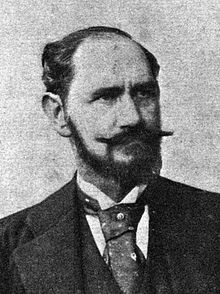Ferdinand Mannlicher
Ferdinand Mannlicher , since 1892 Knight von Mannlicher (born January 30, 1848 in Brüx , Bohemia or Mainz , † January 20, 1904 in Vienna ) was the inventor and designer of a weapon system ( repeater with parcel load ).
Life
Ferdinand Karl Adolf Josef Mannlicher was born as the son of the kuk Oberfeldkriegsommissär Josef Mannlicher and his wife Albertine Haacke. The line of the Mannlicher family can be traced back continuously to the year 1525. For many generations they lived in Brüx / Bohemia; For five generations they provided the mayor as well as postmaster, customs collector, military catering administrator and councilor of the city. A connection with the Augsburg trading family Mannlich has been handed down, but not proven.
After the family moved to Vienna, Mannlicher attended a grammar school in Vienna's 8th district and then studied technology at the Technical University in Vienna. Then he worked as an engineer for the kuk railways. He was interested in weapon technology at an early age and after the defeat of the Austrians by the Prussians at Königgrätz , which was also attributed to the inferior weapon technology of the Austrians, began to focus his activities on this interest. In the course of the tendering by the army for the introduction of a new rifle system, there was a competition between several designers, from which Mannlicher emerged as the winner - after years of public and political discussions, some of which were still conducted with surprisingly personal underhands.
From 1880, Ferdinand Mannlicher designed various multi-loading rifles with a tubular magazine and later with a cartridge magazine in the center shaft. His pursuit was successful. The production of the weapon system patented by him in 1886 (repeater with straight pull lock and parcel load) was taken over by the Österreichische Waffenfabriksgesellschaft under Josef Werndl , in which Mannlicher held substantial shares. Even before the advanced straight-pull rifle Mannlicher model was introduced in the Austro-Hungarian Army in 1895 , other countries around the world equipped their armies with the system-based cylinder bolt rifles with parcel loads.

Mannlicher married Cäcilie Martin on May 21, 1892, and twin daughters Albertine and Cäcilie were born on May 17, 1893. On December 14, 1892 Ferdinand Mannlicher was raised to the Austrian knighthood and member of the manor house of the Austrian Imperial Council for life. Mannlicher received many other honors; He was the bearer of the Austrian Order of the Iron Crown , the Royal Prussian Order of the Crown , the Royal Italian Order of the Iron Crown and an officer of the French Legion of Honor . Today the Mannlichergasse in Hinterbrühl / Vienna and the Mannlicherstrasse in Steyr still remind of him.
After a short illness, Mannlicher died on January 20, 1904 in Vienna. He is buried at the cemetery in Hinterbrühl. After losing a large part of the family fortune, his widow committed suicide on April 12, 1934 with the prototype of a self-loading gas pistol developed by Mannlicher. She is also buried in the family grave in the Hinterbrühl.
Mannlicher's name lives on in the company that was later renamed Steyr-Mannlicher ; Today their rifles are mainly used by hunters and, to a lesser extent, by snipers and for sport shooting. He did not experience the development of the hunting weapon himself; this was operated by the director Schönauer of the Steyrwerke. The Mannlicher-Schönauer is still a widely used hunting weapon today.
literature
- Jaroslav Lugs: Handguns. Systematic overview of handguns and their history , Volume II. Berlin 1956.
- Joschi Schuy: The Werndl weapon system. Josef Werndl - Success and dynamism from Steyr. Linz 1997, ISBN 3-9500718-0-6 .
- Walter Hummelberger : Mannlicher Ferdinand von. In: Austrian Biographical Lexicon 1815–1950 (ÖBL). Volume 6, Verlag der Österreichischen Akademie der Wissenschaften, Vienna 1975, ISBN 3-7001-0128-7 , p. 57 f. (Direct links on p. 57 , p. 58 ).
- Walter Hummelberger: Mannlicher, Ferdinand Ritter von. In: New German Biography (NDB). Volume 16, Duncker & Humblot, Berlin 1990, ISBN 3-428-00197-4 , p. 75 f. ( Digitized version ).
- Hans Stögmüller: Josef Werndl and the arms factory in Steyr. 2nd, expanded edition. Steyr 2012, ISBN 978-3-85068-860-4 .
Web links
Individual evidence
- ↑ a b Jaroslav Lugs: Small arms . Systematic overview of handguns and their history. Volume II, Berlin 1956, p. 200.
- ↑ see literature ÖBL
- ↑ Egbert Mannlicher : Stamm-Tafel of the Mannlicher family from Brüx in Bohemia. Part I. 1525 to 1750
- ↑ Albertine later married Maximilian Reichsfreiherrn von und zu Manndorff zu Wissenau and Pfannhofen (from this marriage comes the Austrian politician Ferdinand Manndorff ), Cäcilie the officer Bruno Rostock.
| personal data | |
|---|---|
| SURNAME | Mannlicher, Ferdinand |
| ALTERNATIVE NAMES | Mannlicher, Ferdinand Karl Adolf Josef Ritter von |
| BRIEF DESCRIPTION | Austrian inventor and designer of a weapon system (repeater with package load) |
| DATE OF BIRTH | January 30, 1848 |
| PLACE OF BIRTH | Mainz |
| DATE OF DEATH | January 20, 1904 |
| Place of death | Vienna |

